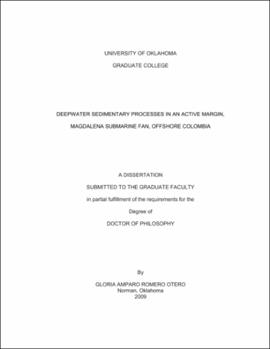| dc.contributor.advisor | Slatt, Roger M | |
| dc.creator | Romero Otero, Gloria Amparo | |
| dc.date.accessioned | 2019-04-27T21:34:13Z | |
| dc.date.available | 2019-04-27T21:34:13Z | |
| dc.date.issued | 2009 | |
| dc.identifier | 99305361702042 | |
| dc.identifier.uri | https://hdl.handle.net/11244/319039 | |
| dc.description.abstract | The Magdalena submarine fan, offshore Colombia, is the result of sediment accumulation in an accretionary prism initiated during the middle Miocene. It is fed by the Magdalena River, which drains the northern Andean Cordillera. Integration of multibeam bathymetry, GLORIA side scan sonar and 2D seismic profiles reveal a series of seafloor deepwater channel-levee systems and mass transport complexes (MTCs) that have evolved as a result of changes in the processes controlling the sedimentation. This study explains the fan evolution during the Pleistocene up to present times and how the tectonic setting has modified the morphology of different architectural elements and their depositional styles. | |
| dc.description.abstract | The river delta migrated westward during Pleistocene to Holocene times, generating eight phases in the submarine fan, mainly represented by channel-levee complexes, unconfined deposits and MTCs filling the interchannel lows. A major Late Pleistocene shift towards the east defined the western abandonment phase of the main fan area (Galerazamba). | |
| dc.description.abstract | The present day fan is located north of the river mouth, revealing its recent activity by deposition of sediment gravity flows which have ruptured submarine cables. Two flow pathways trend down slope through piggyback basins that are linked by knickpoints and canyons. A third flow pathway corresponding to the Aguja Canyon, located northeast of the river mouth, also provided sediment gravity flows which ruptured submarine cables. The flow events are related to different processes on the continental shelf: 1) High flood stages of the river, 2) coastal erosion, 3) longshore drift, 4) hyperpycnal flows and 5) river mouth instability. The sedimentological characteristics of the different deposits should vary because the flow properties are different. Flows through the active Magdalena Canyon and western gullies may be related to high flood stages of the river, giving rise to hyperpycnal flows and instability of the Magdalena delta front. Meanwhile, flows from the Aguja and Sabanilla canyons are associated with longshore drift and coastal erosion. | |
| dc.description.abstract | Mass transport processes have smoothed sea bottom morphology and have been subdivided according to the following causal mechanisms: 1) detached (growth of thrust structures, instability of slope canyon and channel walls) and shelf-attached (major slope failures). | |
| dc.description.abstract | Deformation of the Magdalena Fan occurs at the proximities of the deformation fronts, where buried folds and faults modified the slope. This was recorded in the western fan by increase of sinuosity of the channel-levee systems, forced migration (avulsion) and generation of knickpoints at the higher slope section. Higher slope angles occur at the upper slope, along the northeastern section of the fan, where retrogradational erosion is linked with MTCs as a result of uplift of the inner thrust ridges and the shelf. | |
| dc.description.abstract | Depositional styles vary from the fan to the deformation fronts. Channel-levee systems, unconfined flows and MTCs are typical on the main fan, while thrust deformed areas are dominated by above-slope deposition, represented by unconfined deposits that fill the piggyback basins or are transported downslope to the abyssal plain. | |
| dc.description.abstract | This work provides new understanding of the processes involved in submarine fan evolution in an active margin setting. This knowledge has implications for both petroleum exploration and assessment of shallow hazards of submarine infrastructure in the area. | |
| dc.format.extent | 322 pages | |
| dc.format.medium | application.pdf | |
| dc.language | en_US | |
| dc.relation.requires | Adobe Acrobat Reader | |
| dc.subject | Submarine fans--Colombia--Magdalena River | |
| dc.subject | Sedimentation and deposition--Colombia--Magdalena River | |
| dc.subject | Magdalena River (Colombia) | |
| dc.title | DEEPWATER SEDIMENTARY PROCESSES IN AN ACTIVE MARGIN, MAGDALENA SUBMARINE FAN, OFFSHORE COLOMBIA | |
| dc.type | text | |
| dc.type | document | |
| dc.thesis.degree | Ph.D. | |
| ou.group | Mewbourne College of Earth and Energy::ConocoPhillips School of Geology and Geophysics | |
